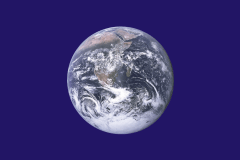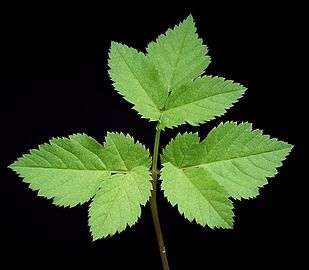Aquatic-terrestrial subsidies
Energy and nutrients derived from aquatic ecosystems and transferred to terrestrial ecosystems are termed aquatic-terrestrial subsidies or, more simply, aquatic subsidies. The most common examples of aquatic subsidies involve organisms that move across habitat boundaries and deposit their nutrients as they decompose in terrestrial habitats or are consumed by terrestrial predators, such as spiders, lizards, birds, and bats.[1][2] This phenomenon is exemplified by aquatic insects that develop within streams and lakes before emerging as winged adults and moving to terrestrial habitats.[3] Fish removed from aquatic ecosystems by terrestrial predators are another important example. Conversely, the flow of energy and nutrients from terrestrial ecosystems to aquatic ecosystems are considered terrestrial subsidies; both aquatic subsidies and terrestrial subsidies are types of cross-boundary subsidies.
Resource Subsidy
Resource subsidy, manifested as nutrients, matter, or organisms, is the flux of energy across ecosystem boundaries.[4] The allochthonous inputs of resources can influence individual growth, species abundance and diversity, community structure, secondary productivity and food web dynamics.[4] Separate from cross-ecosystem predator-prey interactions, resource subsidies supplement the productivity of the recipient species with little to no effect on the source.[5] As a result, resource subsidies are donor-controlled and independent of the recipient consumer or productivity of the recipient habitat.[6]
The abundance and rate of resource subsidy fluxes are mediated by retention and permeability of ecotones and modified by both physical and biotic factors.[7] Recipient habitats differentially respond to the influx of resource subsidies, experiencing the largest effect when comparable resources are low.[8] Similarly, the effect of subsidies fluctuate across and within taxonomic and functional feeding groups.[8] However the effect of subsidy fluxes are volatile due to episodic changes or seasonal cycles in recipient habitats.[8] Cross-ecosystem resource subsidy flows between terrestrial and stream environments are one of the most well studied forms of subsidies.[6]
Aquatic Subsidies
Aquatic subsidies vary spatially and include resources provided from streams to terrestrial areas, from upstream to downstream (or vice versa), and from marine environments to streams.[4]
Subsidies from downstream sources are more common, but not significantly more important than upstream sources.[5] They both provide vital nutrients and energy to ecosystem functions and link interactions between species.[5] Downstream subsidies are characterized by enormous masses of fine particles generated from organism activities that bolster primary productivity and food webs.[4] Likewise, upstream subsidies are generally marine derived fish spawnings (i.e. salmon) that contribute nutrients from carcasses, which support productivity in oligotrophic systems and energy to terrestrial food webs.[5]
The emergence of adult aquatic insects from streams is one of the most distinct and well studied forms of aquatic subsidies. They supply 25-100% of the energy or carbon to riparian species, such as spiders, bats, birds, and lizards.[9] Emergence typically peaks in the summer of temperate zones, prompting predators to aggregate and forage along riparian and stream boundaries.[9] In addition, algae and fine organic matter washed up from high flows provide resource to herbivorous species and for plant germination, respectively.[4]
Ecological importance of aquatic subsidies
While the magnitude of aquatic subsidies to terrestrial ecosystems is low compared to those moving in the reverse direction (from terrestrial to aquatic habitats), aquatic subsidies are generally of higher nutritional quality because they come from animal, rather than plant-based or detrital, sources.[10] In addition to their nutritional value, however, aquatic subsidies are increasingly recognized as important sources of environmental contaminants to terrestrial food webs.[11] In this way, aquatic animals can accumulate pollutants in their tissues and exoskeletons (such as metals and polychlorinated biphenyls) and move them to riparian and terrestrial systems as they emerge or are consumed by terrestrial predators.
Terrestrial Subsidies
Subsidizing in stream metabolism by terrestrial resources have identified the role and importance of terrestrial invertebrates and introduced organic matter.[6]
Drift feeding fish rely on falling terrestrial invertebrates for approximately half their annual energy budget.[9] Variation in the flux of terrestrial invertebrates is dependent on the weather, time – annual and daily – and the riparian architecture.[9] Warmer and more humid temperatures, generally associated with summer and early fall, facilitate greater invertebrate activity and thus larger subsidies, whereas wet seasons reduce the flux of terrestrial invertebrates.[9] While the input of terrestrial invertebrates is greatest during the afternoon and evening of days.[9] Finally, riparian zones composed of closed canopy deciduous vegetation account for higher density and diversity of fishes, due to the greater supply of terrestrial invertebrates.[9]
Terrestrial leaf litter, wood inputs and deposition of pollen are important organic matter sources that augment benthic invertebrate productivity.[4] In particular, these terrestrial subsidies are vital for detritivores and shredders and control their population sizes.[4] Benthic invertebrate communities respond swiftly to changes in the supply of organic matter; the absence of litter stocks led to a drastic decline in productivity and predators in the temperate stream system.[4] Furthermore, provision of organic matter may increase productivity and create hypoxic conditions in streams; however, this is typically uncommon given the high turnover and low residence time of water.[12] In the Mara River basin, though, substantial rates of organic matter and nutrient loading by hippopotami characterize subsidy overloads in hippo pools, stimulate anoxic conditions approximately three times a year, and cause multiple fish kill events.[12]
Measuring aquatic-terrestrial connections
Researchers use several tools to assess how terrestrial and aquatic food webs are connected. Stable isotopes, particularly of carbon, nitrogen, hydrogen, and oxygen, can be used to determine what resources consumers are eating.[13] Other compounds, such as fatty acids, can also be used to trace food web connections between aquatic and terrestrial ecosystems.[14]
See also


References
- Schindler, D.E. & Smits, A.P. (2017). Subsidies of aquatic resources in terrestrial ecosystems. Ecosystems, 20(1),78-93.
- Baxter, C. V., Fausch, K. D., & Carl Saunders, W. (2005)Tangled webs: reciprocal flows of invertebrate prey link streams and riparian zones. Freshwater Biology, 50(2), 201-220.
- Nakano, S., & Murakami, M. (2001). Reciprocal subsidies: dynamic interdependence between terrestrial and aquatic food webs. Proceedings of the National Academy of Sciences, 98(1), 166-170.
- Richardson, John S.; Zhang, Yixin; Marczak, Laurie B. (January 2010). "Resource subsidies across the land-freshwater interface and responses in recipient communities". River Research and Applications. 26 (1): 55–66. doi:10.1002/rra.1283.
- Richardson, John S.; Sato, Takuya (April 2015). "Resource subsidy flows across freshwater-terrestrial boundaries and influence on processes linking adjacent ecosystems: CROSS-ECOSYSTEM RESOURCE SUBSIDIES ACROSS THE WATER-LAND BOUNDARY". Ecohydrology. 8 (3): 406–415. doi:10.1002/eco.1488.
- Larsen, Stefano; Muehlbauer, Jeffrey D.; Marti, Eugenia (July 2016). "Resource subsidies between stream and terrestrial ecosystems under global change". Global Change Biology. 22 (7): 2489–2504. Bibcode:2016GCBio..22.2489L. doi:10.1111/gcb.13182. PMID 26649817.
- Ballinger, Andrea; Lake, P. S. (2006). "Energy and nutrient fluxes from rivers and streams into terrestrial food webs". Marine and Freshwater Research. 57 (1): 15. doi:10.1071/MF05154. ISSN 1323-1650.
- Marczak, Laurie B.; Thompson, Ross M.; Richardson, John S. (January 2007). "Meta-Analysis: Trophic Level, Habitat, and Productivity Shape the Food Web Effects of Resource Subsidies". Ecology. 88 (1): 140–148. doi:10.1890/0012-9658(2007)88[140:mtlhap]2.0.co;2. ISSN 0012-9658. PMID 17489462.
- Baxter, Colden V.; Fausch, Kurt D.; Carl Saunders, W. (2005-01-18). "Tangled webs: reciprocal flows of invertebrate prey link streams and riparian zones: Prey subsidies link stream and riparian food webs". Freshwater Biology. 50 (2): 201–220. doi:10.1111/j.1365-2427.2004.01328.x.
- Bartels et al. (2012). Reciprocal subsidies between freshwater and terrestrial ecosystems structure consumer resource dynamics. Ecology, 93(5), 1173-1182.
- Walters, D.M., Fritz, K.M., Otter, R.R. (2008).The dark side of subsidies: adult stream insects export organic contaminants to riparian predators.. Ecological Applications, 18(8), 1835-1841.
- Dutton, Christopher L.; Subalusky, Amanda L.; Hamilton, Stephen K.; Rosi, Emma J.; Post, David M. (December 2018). "Organic matter loading by hippopotami causes subsidy overload resulting in downstream hypoxia and fish kills". Nature Communications. 9 (1): 1951. Bibcode:2018NatCo...9.1951D. doi:10.1038/s41467-018-04391-6. ISSN 2041-1723. PMC 5956076. PMID 29769538.
- Vander Zanden, H.B., Soto D.X., Bowen, G.J., Hobson K.A. (2016). Expanding the Isotopic Toolbox: Applications of Hydrogen and Oxygen Stable Isotope Ratios to Food Web Studies. Frontiers in Ecology and Evolution, 4.
- S.J. Iverson (2009). Tracing aquatic food webs using fatty acids: from qualitative indicators to quantitative determination. In: Kainz M., Brett M., Arts M. (eds) Lipids in Aquatic Ecosystems. Springer, New York, NY.